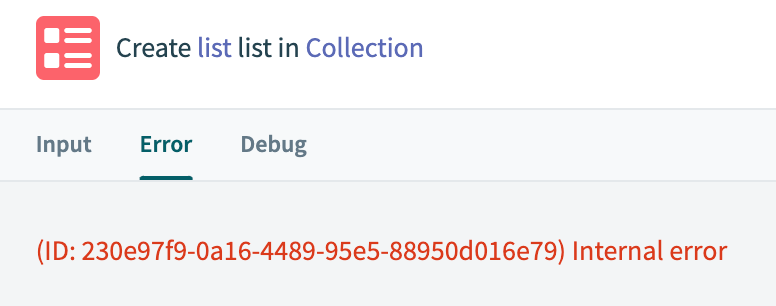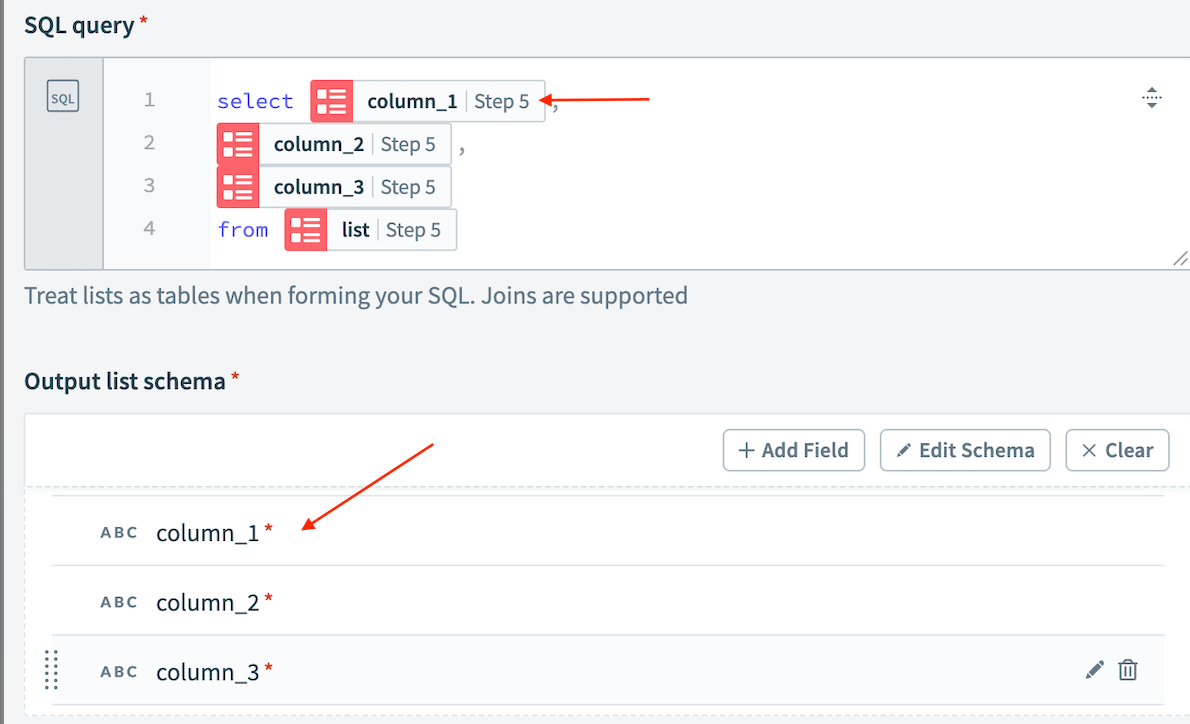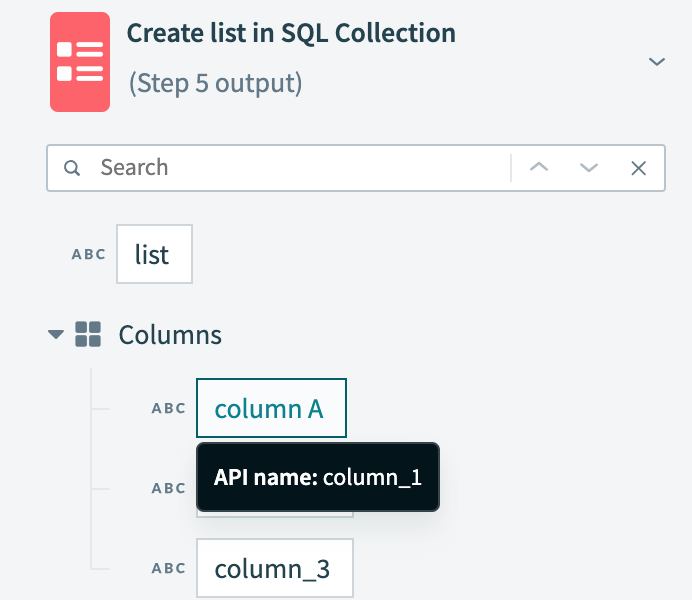# Internal and upstream/downstream application errors
Identifying the origin of an error in your solution is crucial for effective troubleshooting. Understanding whether the issue occurred within Workato, an intermediary middleware layer, or a backend database can help you streamline your efforts and achieve a timely resolution.
Differentiating between internal and external errors is important for both triggers and actions. Action errors typically receive more attention due to their complexity. However, addressing trigger errors is also critical, as they may indicate connectivity or configuration issues, particularly when interacting with external systems.
The following sections provide specific troubleshooting steps for each type of error:
# Internal errors
Refer to the following sections for common scenarios and troubleshooting methods for internal errors in Workato's platform-specific actions:
# SQL Collection by Workato
SQL Collection by Workato uses SQLite. Ensure your SQLite code adheres to the SQLite version 3.42.0 standards.
Refer to the relevant tab for troubleshooting tips based on the scenario you encounter:
# Parsers and readers (XML/JSON/CSV)
Errors with parsers typically result from data input that does not match the expected formats.
Complete the following steps to troubleshoot parsers and readers:
Ensure that the data does not contain prohibited strings or delimiters, such as commas in a CSV string.
Ensure XML strings do not contain unescaped < or > symbols, and handle backslashes carefully when parsing data.
Verify that your source data adheres to the expected format rules. Use tools such as Notepad++ or Sublime Text for on-prem validation.
Follow XML rules for parsers, and ensure your sample document accurately represents the documents you are parsing.
# RecipeOps
RecipeOps actions can help automate troubleshooting and error handling in your Workato recipes. They offer key functions to manage and resolve errors effectively, including the following:
Error aggregation
Use RecipeOps to gather errors from various jobs and recipes.
Recipe restart
Restart recipes that have been interrupted, typically due to trigger errors.
Action retry scope
Implement retries in the On Error block, retrying specific actions within a Monitor block.
Complete reruns
Repeat all job actions using the original trigger data.
System recovery
Support recovery strategies during frequent system outages, such as server downtimes or critical errors.
Errors associated with RecipeOps are uncommon. Learn more about RecipeOps.
# Upstream/downstream application errors
Upstream and downstream application errors arise from applications connected to Workato, rather than from Workato itself. They often occur when connecting to external or internal systems.
Common scenarios include the following:
Cloud connections
Errors involving interactions with external cloud services such as Salesforce, Netsuite, or ServiceNow.
On-premise connections
Issues that occur when dealing with on-premise solutions such as SAP.
Database interactions
Errors due to connection timeouts, data discrepancies, or schema changes when interacting with databases.
HTTP requests
Problems with the Workato HTTP action, such as incorrect endpoints, timeouts, or payload formatting issues.
Custom connectors
Errors related to custom connectors can result from outdated APIs, incorrect configurations, or service downtimes.
File system connections
Errors can occur when actions involve file systems like SFTP or FTP due to permission issues, incorrect file paths, or server downtimes.
Handling these application errors requires an in-depth understanding of the external system. While Workato support can offer general guidance, consulting an expert on the specific external application can help you quickly pinpoint and resolve the problem.
# Troubleshoot external cloud connections
When managing actions related to external cloud systems in Workato, understanding the nature and source of errors is essential. Complete the following steps to troubleshoot these issues:
Check the HTTP error codes to identify why the call from Workato failed.
Inspect the debug tab for detailed HTTP interactions between Workato and the external system. If the tab only shows the execution time or is unavailable, try rerunning the job for more details.
Determine if the errors are intermittent or constant. Intermittent errors may indicate temporary connectivity issues, while constant errors suggest problems with the external application or your Workato request.
Consult the external application for logs or records related to the error in Workato. If there are no logs of Workato's message, it may indicate connectivity issues or rate limit constraints.
# Troubleshoot Workato HTTP actions
When using an HTTP connector action in Workato to connect with an external endpoint, complete the following steps to troubleshoot potential issues:
Verify connectivity to ensure the external application that Workato is attempting to reach is hosted on a server with internet access.
Include Workato's IP addresses if the application needs to be added to an allowlist.
Verify incoming calls by checking the application logs for any calls from Workato.
# Categorize HTTP status responses
After addressing connectivity, IP allowlisting, and incoming call verification, categorize the errors according to the status codes outlined in the following tabs:
# Troubleshoot on-prem connectivity
When troubleshooting on-prem connectivity issues, log files are critical for gaining insights into potential problems.
The on-prem agent (OPA) logger creates a new log file at the beginning of each day, according to the on-premise system's time. Additionally, a new log file is generated once the file size exceeds 20 MB. If multiple log files are created in a single day due to this size limit, they are sequentially numbered for differentiation. For example:
/agent-2019-11-01.0.log: This is the first file created for the day. If logs for the day don't exceed 20MB, this is the only file./agent-2019-11-01.1.log: This is the next log file created if additional logs are needed that day. The last number in the file name gets incremented if there is a need for more files in that particular day.
OPA logs are stored in different locations depending on whether your system is running Windows or Linux. The following sections explain how to access these logs on each platform:
# Windows
Log files are stored in %SYSTEMROOT%\System32\LogFiles\Workato by default for on-prem agents operating as a Windows service. You can navigate to this file manually or use the shortcut in the Start menu under All apps > Workato.
Complete the following steps to change the log storage location:
Open the Windows Start menu.
Go to All apps > Workato.
Click Service Wrapper Configuration to open the configuration menu.
Go to the Logging tab.
Enter a new log storage location in the Log path field.
Click Apply, then OK.
OPA LOG CONTENTS
The level of detail included in your OPA logs depends on your agent configuration. Refer to the Workato logging levels section for more information.
# Linux
Log files are stored in /var/log/messages by default for on-prem agents operating as a Linux service through systemd. Because this file also contains logs from other Linux services, you must use the journalctl command to access OPA specific logs.
journalctl -u [name of the OPA service].service
The -u switch filters the logs returned by the service that created them. Replace [name of the OPA service] with the name you set for the OPA during installation.
You can further refine your log search using the following commands:
> [output-file]: Exports the result ofjournalctlto a file.--since: Limits the generated logs to after a specific date and time.--until: Limits the generated logs to before a specific date and time.
For example:
journalctl -u workato.service --since "2020-07-26 23:15:00" --until "2020-08-5 23:20:00" > OPALogs.txt
Refer to Loggly's Using journalctl (opens new window) guide for additional journalctl information.
OPA LOG CONTENTS
The level of detail included in your OPA logs depends on your agent configuration. Refer to the Workato logging levels section for more information.
# IP allowlisting
Ensure that you complete the necessary IP allowlisting steps if the external application requires it.
Last updated: 5/21/2025, 5:22:32 AM
 Create list action error
Create list action error Verify input
Verify input Sequence your output list schema
Sequence your output list schema Use API name
Use API name